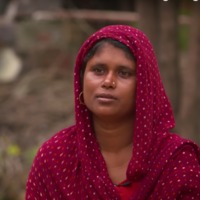
Sanjida
It is estimated that almost 8 million people are living in conditions of modern slavery in India (GSI 2018). The skewed sex ratio in some regions of India has fuelled the trafficking and selling of women and young girls as brides within India. Women are reportedly sold off into marriage by their families, sometimes at a young age, and end up enduring severe abuse, rape and exploitation by their husbands. It is also reported that women and girls from impoverished backgrounds have been lured by promises of marriage by younger men from urban areas, then forced into sex work once married. Sanjida was trafficked from Assam to Haryana when she was 10 years old. She was kept by a family for four years who forced her to do manual labour in the fields.

Joyce
Joyce is an African American woman who was born in Ocala, Florida. She subsisted on migrant work from the age of nine, and from 1985 was enslaved by the Bonds family, who operated a ring of labor camps from Florida to the Carolinas. After seven years in bondage she escaped with her husband Huey. Sometimes the experiences of 21st-century slaves encompass not only the narrator’s turn from slavery to freedom, but also a reversal for their enslavers. In 1993, members of the Bonds family were charged with conspiracy to hold workers in a state of peonage, distribution of crack cocaine, and two violations of the federal Migrant and Seasonal Agricultural Worker Protection Act. The Bonds were released from prison in 2000, and Joyce recently received word of their fate: while she had experienced stasis and entrapment (“there’s nowhere to run”), the Bonds now spend their days trapped by the side of a highway, picking up cans for a living. In her narrative, Joyce further inverts slavery’s power dynamic by using the vague and threatening third-person pronoun “they” to counter her own dehumanization (“treated like a dog”).